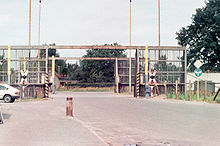
Size of this preview: 800 × 530 pixels. Other resolutions: 320 × 212 pixels | 640 × 424 pixels | 1,024 × 679 pixels | 1,280 × 848 pixels | 1,565 × 1,037 pixels.
Original file (1,565 × 1,037 pixels, file size: 1.41 MB, MIME type: image/jpeg)
File history
Click on a date/time to view the file as it appeared at that time.
| Date/Time | Thumbnail | Dimensions | User | Comment | |
|---|---|---|---|---|---|
| current | 20:35, 30 September 2008 |  | 1,565 × 1,037 (1.41 MB) | BajanZindy | {{Information |Description=The closed Elefantentor (Elephant's Gate) with a Deutsche Reichsbahn train passing. It was erected to avoid citizen commiting "Republikflucht". |Source=self-made |Date=1991 |Author=BajanZindy |Permission=All rights released |oth |
| 16:57, 28 September 2008 |  | 1,585 × 1,080 (1.5 MB) | BajanZindy | {{Information |Description={{en|1=The closed Elefantentor (Elephant's Gate) with a Deutsche Reichsbahn train passing. It was erected to avoid citizen commiting "Republikflucht".}} |Source=self-made |Author=BajanZindy |Date=1991 |Permis |
File usage
The following pages on the English Wikipedia use this file (pages on other projects are not listed):
Global file usage
The following other wikis use this file:
- Usage on de.wikipedia.org
- Usage on ko.wikipedia.org
